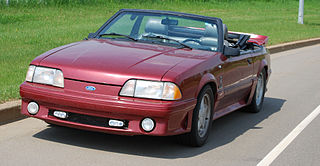
Mercury is a defunct division of the U.S. automobile manufacturer Ford Motor Company. Marketed as an entry-level premium brand for nearly its entire existence, Mercury was created in 1938 by Edsel Ford to bridge the price gap between the Ford and Lincoln vehicle lines. In a similar context, Buick and Oldsmobile served the same role within General Motors while Mercury competed against the namesake brand of Chrysler.

The Continental Mark III is a personal luxury car that was marketed by the Lincoln division of Ford Motor Company from the 1969 through 1971 model years. The Mark III was marketed as the flagship vehicle of Ford Motor Company, serving as a successor to the 1956–1957 Continental Mark II. In what would become a three-decade rivalry, the Mark III was developed as a direct competitor to the Cadillac Eldorado after its shift to the personal luxury coupe segment in 1967.

Personal luxury car is a North American car classification describing somewhat sporty, sophisticated coupes that emphasized comfort over performance and were available with numerous options. These mass-market models prioritized comfort, styling, and a high level of interior features. The domestic manufacturers most often combined engineering, design, and marketing to develop upscale, distinctive "platform sharing" models that became highly profitable.

The Whiz Kids were a group of ten United States Army Air Forces veterans of World War II who became Ford Motor Company executives in 1946.
The name Ford Corsair was used both for a car produced by Ford of Britain between 1963 and 1970 and for an unrelated Nissan based automobile marketed by Ford Australia between 1989 and 1992.

The Ford Fox platform is an automobile platform that was used by Ford Motor Company. Introduced for compact sedans in the 1978 model year, the Fox architecture was utilized for a wide variety of configurations for Ford and Lincoln-Mercury vehicles. In its original form, the platform was used until 1993, with a substantial redesign of the Ford Mustang extending its life through the 2004 model year. With the exception of the Panther platform, the Fox platform is the longest-produced vehicle architecture by Ford Motor Company.
The Ford DEW platform was Ford Motor Company's midsized rear-wheel drive automobile platform. The D/E nomenclature was meant to express an intermediate size between D- and E-class vehicles, while the W denoted a worldwide platform. The platform was developed by both Ford and Jaguar engineers, and debuted in the Lincoln LS sedan. Its de facto predecessor in Europe was the DE-1 platform which underpinned the 1985 Ford Scorpio, however this vehicle was cancelled in 1998 without a direct replacement as in the European market, buyers were increasingly turning away from executive class cars manufactured by mainstream manufacturers.

The Motor Trend Car of the Year (COTY) is an annual award given by Motor Trend magazine to recognize the best new or significantly refreshed car in a given model year.
Frank Hershey (1907–1997) was an American automobile designer and student of General Motors Vice President of Design Harley Earl, widely known for his 1932 Peerless V-16 prototype, 1949 Cadillac tailfins and the 1955 Ford Thunderbird.
Semon Emil "Bunkie" Knudsen,, was a prominent American automobile executive.
Joseph E. Oros Jr. was an automobile stylist for Ford Motor Company over a period of 21 years — known as the Chief Designer of the team at Ford that styled the original Mustang, and for his contributions to the 1955 Ford Thunderbird. Oros was also an artist, sculptor, painter and industrial designer, having designed appliances and other products.

The Lincoln Mark series is a series of personal luxury cars that was produced by Ford Motor Company. The nomenclature was launched in 1956, as the 1939-1948 Lincoln Continental was succeeded by the Continental Mark II. From 1958 to 1960, the Mark III, IV and V were marketed by Mercury-Edsel-Lincoln (M-E-L) Division. Following a hiatus, the Mark series was relaunched in 1968 by Lincoln-Mercury; six further generations were produced through 1998.
Elwood P. Engel was Chrysler Corporation's design chief from 1961 until 1974.

The first generation of the Ford Thunderbird is a two-seat convertible produced by Ford for the 1955 to 1957 model year, the first 2-seat Ford since 1938. It was developed in response to the 1953 Motorama display at the New York Auto Show, which showed the Chevrolet Corvette. The Corvette in turn was developed in response to the popularity of European sports cars among Americans.

The second generation Ford Thunderbird was produced by Ford for the 1958 to 1960 model years as a successor to the popular 1955-1957 two-seater. In response to Ford-conducted surveys two major changes were made to attract potential buyers: two rear seats were added and the level of luxury and features of a full-sized car were incorporated into a mid-size platform.

The tenth generation of the Ford Thunderbird is a personal luxury car that was produced by Ford for the 1989 to 1997 model years. On December 26, 1988 a completely redesigned Thunderbird was introduced as a 1989 model alongside its sister car, the Mercury Cougar. Developed on Ford's new MN12 platform from the second quarter of 1984, the new Thunderbird featured a more aerodynamic body that was slightly shorter in overall length relative to the 1988 Thunderbird but had a nine-inch-longer wheelbase.

The eleventh generation of the Ford Thunderbird is a personal luxury car that was produced by Ford for the 2002 to 2005 model years. It was based on the Ford DEW platform. Although it was initially well received by the automotive press, garnering accolades such as the Motor Trend Car of the Year and a nomination for the North American Car of the Year in its first year of existence, many publications regarded the Thunderbird's revival rather more frostily after a few years; it garnered a place on Car and Driver magazine's 2009 list of "The 10 Most Embarrassing Award Winners in Automotive History".













